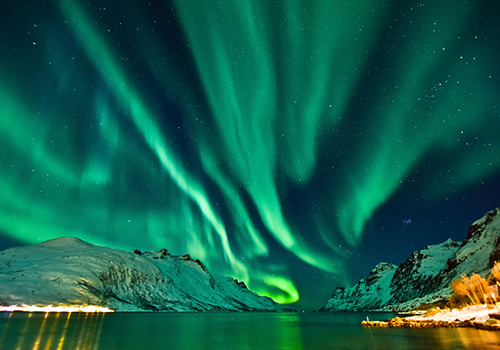Used often during festivals, fairy lights burst onto the décor scene around a decade ago on social media. Tiny bulbs most popularly a pale yellow or bright gold colour were draped around bedposts, trees, on walls, around Pinterest projects and the world cooed in awed wonder. They looked completely magical and everyone fell in love. But did you know the Earth has its own fairy lights too? Much bigger, brighter, and bolder than anything human beings could manufacture, then again, we wouldn't expect any less from grand Mother Nature!
These natural vibrant dancing lights are, in reality, collisions between electrically charged particles from the sun as they enter the earth's atmosphere. The lights are seen in both the northern and the southern hemispheres, above both poles. They are known as 'Aurora Borealis' in the north after Aurora, the goddess of dawn and Boreas the Greek god of Northern air; and 'Aurora Australis' in the south since the term 'Australis' means 'of the south.' The lights are more commonly called Northern Lights in local parlance but the term Aurora Borealis was first coined by Galileo in 1916.
These lights seem to appear in many colours although they are most commonly seen as pale pink or green. People have reportedly spotted hues of red, yellow, blue, and violet too. The lights span across the sky in a variety of patterns such as curtains, arcs, streamers, ripples, shooting rays, patches, or scattered bursts of light.

So why do these auroras occur and what makes them do so? They are produced when charged particles from the sun's atmosphere (in the form of protons and electrons) collide with Earth's upper atmosphere where they lose their energy. The resultant ionization and excited state of these particles lead to them emitting lights of multiple colours then visible to the naked eye. It was in the 1950s that solar winds were discovered as the carrier of the charged particles from an opening in the sun's atmosphere. Auroras occur in a band called the 'auroral zone' which is around 3-6 degrees wide in latitude and around 10-20 degrees wide at the geomagnetic poles.
The most common colour seen is a pale greenish-yellow hue which is caused by oxygen molecules located approximately 60 miles above the Earth. Completely red auroras are produced by high-altitude oxygen, while Nitrogen is believed to produce blue or reddish-purple aurora.
'Auroral Oval' is the term given to regions currently displaying these awe-inspiring displays of light. Parts of Alaska, certain towns in Canada, Scandinavia are all great spots from where to view these lights as they are close to the poles. Auroras are blocked by the polluted skies and the sheer amount of light emitted by modern cities so your best bet is finding a remote town and setting up camp there for the night. It will be the best camp you will ever go to since the showstopper is literally out of this world!